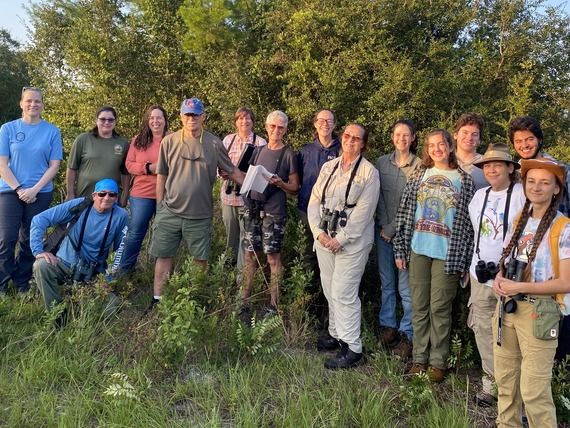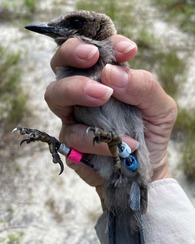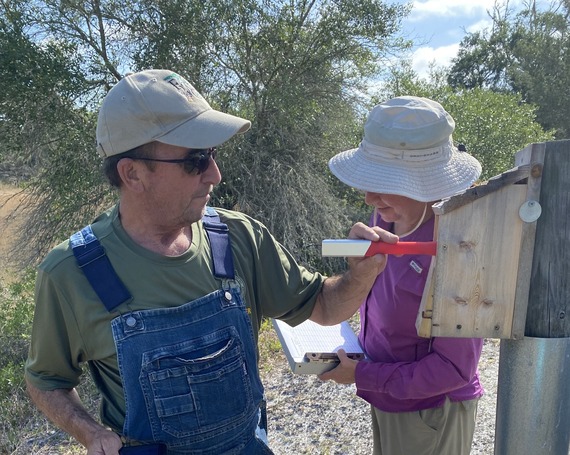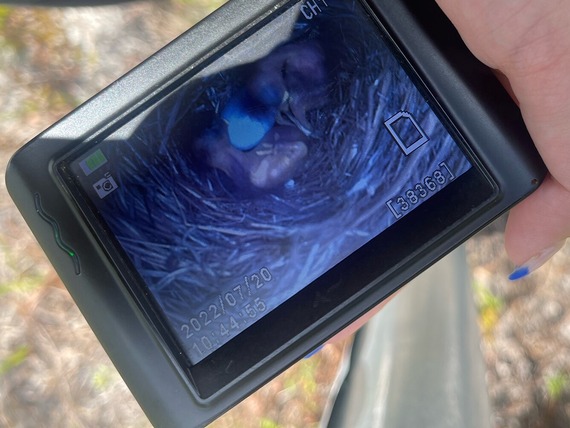 A group of FWC volunteers who assist with bird projects.
The Florida Fish and Wildlife Conservation Commission and its partners offer a variety of volunteer opportunities where bird lovers can get hands-on experience contributing to bird conservation efforts across the state. Contact a volunteer administrator to learn how to volunteer for any of the programs below.
Shorebirds and Seabirds: In partnership with the Florida Shorebird Alliance, FWC staff monitor shorebirds and seabirds during the breeding season. Volunteers can be involved with bird surveys, sign posting for beach nesting birds, habitat enhancement and bird stewardship. The monitoring component of this volunteer opportunity runs from March to August. Volunteers who are familiar with shorebird and seabird species are preferred.
Bluebird Nest Box Monitoring: Bluebirds are cavity nesters, but the supply of natural nesting cavities has diminished over the years because of habitat loss, the removal of dead trees and limbs, and a shift from the use of wooden fence posts to metal posts. Fortunately, bluebirds readily nest in artificial nest boxes and widespread efforts to provide these boxes have helped reverse dramatic population declines. Volunteers maintain and monitor bluebird nest boxes in Marion County from February through August.
 |
|
Jay Watch: The Florida Scrub-Jay is found nowhere else in the world. Jay Watch is a community science program that trains and supports volunteers to conduct scientific surveys measuring annual nesting success and counting the total number of Florida Scrub-Jays. Volunteers conduct surveys to monitor populations of the endemic Florida Scrub-Jay in Marion and Citrus Counties on weekdays from mid-May through July 15. |
Southeastern American Kestrel Monitoring: Kestrels nest primarily in large dead trees in cavities previously excavated or hollowed out by woodpeckers. Southeastern American Kestrels are listed as threatened in Florida due to declines in nesting and foraging habitat resulting from urbanization and changes in agricultural practices. FWC uses nest boxes to increase populations of these threatened birds. Volunteers assist with maintaining and monitoring nest boxes from April to July.
 Scott and Carey LaRosa using a “peeper camera” to inspect a nest box for the presence of a nest, eggs, or chicks of Eastern Bluebirds at Ross Prairie State Forest.
Kite Tales spoke with Scott and Carey La Rosa about their experiences volunteering on projects monitoring Florida Scrub Jays and building nest boxes for Eastern Bluebirds with FWC. Check out highlights from the interview below.
How did you start volunteering with FWC?
When we first got to Ocala I was looking up volunteer opportunities on the FWC website and jays just happened to come up, because it was just that time of year when they do Jay Watch. I had never heard of a Scrub Jay before I moved here, but when I did I thought it was such an amazing bird. We've been doing Jay Watch now for four years, at least.
When we first started we were newbies, we didn’t really know much, but as the years went by we came every year and we learned and they realized we were reliable, so the last two years we've been team leaders.
We got invited to do Eastern Bluebird nest box counting because we were volunteers for Scrub Jays. Biologists emailed us and said, “Hey, would you like to count bluebirds?” and we were like, “Yes, please.” They saw that we were enthusiastic volunteers with the jays and they invited us to do something else. They got back to us immediately and sent the information to sign up for the training. You can pick which days and which locations you want to do, so it was easy.
When we started doing bluebird nest boxes it kicked our enthusiasm up a whole notch. I always liked birds, but I never really thought about bluebirds. Then doing this project with the Eastern Bluebirds I realized, “Oh, it really is important.” And then I started noticing bluebirds in my yard and putting up boxes. They also do nest boxes for Southeastern American Kestrels and I wanted to climb a tree and put in a kestrel nest box, but volunteers aren’t allowed to. They use professional tree climbers. Volunteers build the boxes and count the birds that use them. To do that you use a camera mounted on a tall pole, so you don’t need to climb.
 An image of young Eastern Bluebird chicks taken by a peeper camera operated by volunteers monitoring nestboxes.
How do you use the camera to monitor the nests?
The Eastern Bluebird nests are about five feet up. You have a little peeper cam, and you just peep in there and you can see if it's an active nest or an inactive nest, and take pictures if there’s eggs or babies. They use the same camera system for all the bird boxes like Wood Ducks, kestrels, woodpeckers. It’s very lightweight and easy to use. You knock on the box real quick to let them know you’re coming, so you don’t freak them out too much. The adults usually will flee when you get close to the box, but we make it as quick as we can so it doesn’t disturb the birds too much.
What’s the most rewarding part of volunteering?
It's really fun to be able to feel like you're helping, and you kinda get special access and you get to meet cool, smart people. You feel like you’re a biologist. When we drive out of the gate, we slap each other a high five and go, “Good job, citizen scientists.” And to see the new babies, when you're looking in a nest box with a camera and there was nothing in there last week, and now there's four eggs and then they hatch, it's just very gratifying to see them doing well.
I didn't realize what an impact I would make, putting up these boxes. It seems like a simple thing. We've seen so many birds and eggs, and just by putting up those boxes we’re increasing the population of these species.
What would you tell others who are considering volunteering?
Volunteer. It's just the right thing to do, and it's fun. Google volunteer opportunities, go to Audubon hikes or tours, make good contacts. Right now all I have to do is call the FWC volunteer program biologist on his phone and he'll tell me about opportunities. If you enjoy green spaces and you enjoy being able to bird, then make it a point to volunteer, give back a little bit. Get out there. If you see the places, you're gonna want to save them.
Contact a volunteer administrator to start your own journey volunteering with FWC’s bird programs!
|